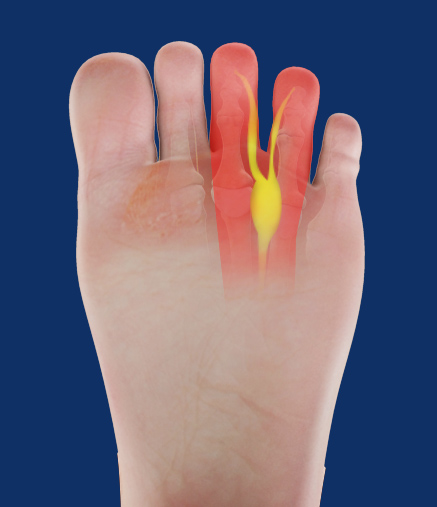
A Morton’s neuroma, also known as an intermetatarsal neuroma, describes the irritation and swelling of the tissue that surrounds a nerve in your foot. As our nerves are responsible for our ability to feel, a swollen nerve can produce an array of unusual sensations in our feet, including tingling, burning and numbness.
What causes a Morton’s neuroma?
A Morton’s neuroma most often develops between the third and fourth toes, close to the ball of the foot. Less commonly it occurs in the space between the second and third toes, however, it can develop between any of the bones. Like with anything in the body, when the nerve is repeatedly rubbed, compressed or irritated in some way, damage can occur, which results in swelling. The cause of this irritation may be from:
- Tight footwear – especially if the area around the toes is narrow or pointed
- Foot problems like bunions and hammertoes – the changes to the structure of the joints and moving bones can irritate nerves
- Over-pronation – excessively rolling downwards of the feet, flattening the arch
- Biomechanical foot problems – high arches, excess flexibility of the joints in the feet
- Trauma – like dropping something on the foot
- High heels – depending on the height, can place most of the weight on the forefoot
- Overuse – physical activities or work activities that put a lot of pressure on the feet, especially the forefoot
Signs & symptoms: Is it a neuroma or something else?
 With a neuroma, you can often feel a distinct, painful mass between two long bones of the feet – and this mass may ‘click’ if you move the bones around it with your fingers, up and down. It may feel like you’re walking on a pebble. If you put your hands on the outer borders of your foot, and squeeze them together, this usually causes pain with a neuroma – as will anything that puts pressure on it like tight or heeled shoes.
With a neuroma, you can often feel a distinct, painful mass between two long bones of the feet – and this mass may ‘click’ if you move the bones around it with your fingers, up and down. It may feel like you’re walking on a pebble. If you put your hands on the outer borders of your foot, and squeeze them together, this usually causes pain with a neuroma – as will anything that puts pressure on it like tight or heeled shoes.
Neuromas are often differentiated from other causes of foot pain by the presence of the nerve-related symptoms we mentioned earlier – numbness, tingling, pins and needles, burning and more. Muscle and joint problems don’t tend to carry these symptoms unless a nerve is involved.
Treating and preventing neuromas
The best way to help prevent a neuroma is to avoid overloading the forefoot. This means avoiding tight or narrow shoes, high heels, and instead keeping your feet well supported and comfortable.
If you do suspect you have a neuroma, treatment is very much possible, and every neuroma must be approached on a case-by-case basis. This is as their severity and size can vary greatly – as does the person suffering from the neuroma and their occupations and daily circumstances. What works best for you may not work for someone else – so always have your neuroma professionally assessed and treated by your podiatrist. Here at Masterton Foot Clinic, we may use:
- Padding and strapping: Applying specific padding at the ball of the foot may alter your foot function to help relieve your painful symptoms caused by the neuroma
- Orthotics: Orthotics that use a specialised ‘neuroma dome’ can effectively relieve painful symptoms by removing any pressure off the neuroma and gently spacing the bones surrounding them. Without continuing pressure on the neuroma, the swelling can have a chance to reduce
- Anti-inflammatories: anti-inflammatory medication and creams can be used to help you get relief from the pain. Just remember that these are a temporary measure won’t fix the problem – if you keep putting pressure on the nerve like you were before it may keep getting worse
- Ice & rest: applying ice to the foot works in the same way as anti-inflammatories – with the goal of reducing the swelling, but without treating the problem. Resting will help relieve pressure off the swollen nerve to so that it doesn’t keep getting aggravated
- Stretching: tight muscles may be adjusting your foot biomechanics and contributing to pain. In this case, stretching your calves may help your progress
- Footwear: Wear shoes with plenty of room at the toes, low heels, and laces or buckles that allow for width adjustment. This will help you walk more comfortably and assist your recovery. Remember to avoid walking with bare feet throughout your recovery
- Surgical options: If early treatments fail and you can’t get relief from your pain, surgery may be an option. Due to the invasive nature of surgery, the need to cut through tissue and the recovery, surgery should almost never be a first-line treatment solution, especially when other gentle but effective treatment methods are available
Frequently Asked Questions
Is a Morton’s neuroma permanent?
A Morton’s neuroma is not permanent in the sense that it can be managed effectively with the right treatment. Many people find relief from their symptoms through the conservative care options we offer. For the few stubborn cases where symptoms may persist, we can refer you to an orthopaedic surgeon to discuss your options. With appropriate care, the condition does not have to be permanent.
Can a Morton’s neuroma go away on its own?
In some instances, mild cases of Morton’s neuroma may improve or resolve on their own with rest, offloading and appropriate footwear changes. However, it’s important not to rely solely on this and seek medical advice for proper evaluation and treatment. The first step is also identifying that it really is a neuroma you’re dealing with and not another condition that presents with similar symptoms and location.
Can I prevent a Morton’s neuroma?
While nothing you do can guarantee prevention, you can definitely reduce your risk by wearing comfortable, properly fitting shoes with adequate arch support, avoiding high heels and tight footwear,, and addressing any foot problems promptly.
What are the complications of an untreated Morton’s neuroma?
If left untreated, a Morton’s neuroma can lead to longstanding foot pain and potential complications such as nerve damage.
